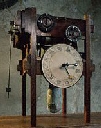Under construction -- All these clocks are on display at the House of
Clocks, and hopefully we will have more of their descriptions and
history up on this page soon. In the meantime, enjoy the pictures...
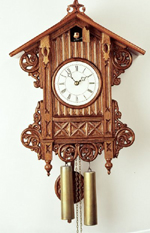 The Cuckold's Clock
The Cuckold's Clock
HOC222756
(On indefinite loan from Scotland Yard's Black Museum)
Exhibited in the Rogue's Gallery
This clock is a material witness to three grisly episodes of
domestic violence. To say that the clock is in any way to blame would
be a foolish and superstitious accusation, but none-the-less the
deaths of Lizzie Barlow, Ruth Harriet and Charlotte Brooke all
occurred beneath its innocent white face. Charlotte Brooke's
relationship with Sir Henry Cope was proved in court to be beyond
reproach and yet still there are three (repaired) bullet holes in the
clock's body, three dead women, and three young men with life
sentences, currently enjoying her Majesty's hospitality. Young couples
are not encouraged to browse. -- Capt.S.S. Hendley
|
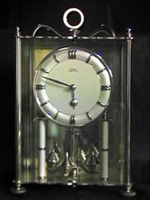 HOC1205
HOC1205
This is the treasured clock of the young Wescott sisters, and can be
seen in the famous photograph of the pair, a picture of innocence in
their white petticoats, taken mere hours before their removal to
Lentworth Asylum in the winter of 1894. It was there in the sitting
room on that terrible night which saw the death of their parents and
brother, and it was later brought to them in their cold and cramped
cell, its presence all that would calm them and silence their wretched
screams. The ward nurse notes in her diary that the children would
often be seen kneeling with the clock placed in front of them, eyes
fixed on its face and the languid motion of the hands, lips moving
soundlessly as if in answer to unspoken questions. -- Mordecai Mulroney
|
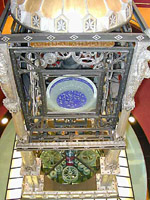 The Zodiac Clock
The Zodiac Clock
HOC840294
The following description is not entirely up the scholarly standard
which the House of Clocks generally prefers for its published
annotations and descriptions, but as our staff of horological experts
have been reluctant (indeed, have outright refused) to invest the time
and effort in studying the timepiece to document it further, we have
let this entry stand until a replacement can be written.
Not a standard timepiece, this device measures not in the hours of the
day, but in the passages of the sun, moon, and planets through the
houses of the western astrology. It is beautifully constructed and
devious in design. Instead of numerals, the dial has the twelve zodiac
signs marked in its divisions. Eleven hands in an intricate dance of
the auspices of life and death. The imperceptible movements of Pluto
that take years of precise study to even measure. From my knowledge
of the Greek zodiac, the timepiece seems to have uncannily adjusted
its measures to its current location and now serves as an accurate
accounting of the natal signs of those born in this land. This is
perplexing as there is no apparent way to reposition the hands and the
imprint of the case implies that it was contructed in ______ (possibly
the Netherlands though no consistent agreement was reached by the
translators, though the list of translations ran the gamut from "The
Hindquarters of The Grave! " to "The Backside of Hell") in 1847. At
first I thought the timepiece was silent in operation, however over
the years I have learned to hear its infernal workings. Rather than
ticking or chiming, the only sounds from this blasphemous device are
thousands of whispering voices naming each birth and each death as the
moments of life slips in and out of shadow. My study of this
timepiece have vexed me as no other in our exile. Distance does not
diminish its voices. Nor did the study of other clocks release me
from its thrall. My dreams are of destroying it and freeing myself, my
very spirit from these maddening breaths that it issues. I would
smash it and grind its workings beneath my heel, if not for the
whisper most clear when I reach my limits and prepare to strike. It
is an insidious fiend. That whisper, that morbid exhalation, fills me
with despair as it says "Must I name you a second time?". The voice I
know well, for it is my own... -- Joshua ben Levi
|
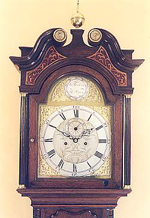 The Gypsy Girl's Clock
The Gypsy Girl's Clock
HOC13024
The grandfather clock is watching.
It's waiting for my eyes,
To fall asleep,
So it can creep,
And take me by surprise.
The grandfather clock, is patient,
It's been so very long.
It tells the time.
It creaks and chimes,
But counts the hours wrong.
The grandfather clock is hungry,
I fear that it might walk,
Right in my room,
And toll my doom;
I hear it tick and talk.
The grandfather clock is waiting,
It's breathing in and out.
I hear its call,
As midnight falls;
I know without a doubt . . .
The grandfather clock is watching.
But I refuse to crack.
I'll stay aware,
And stand and stare,
And grimly watch it back.
(translated from the Croatian by Hake Cross O'Reed)
(The following is from O'Reed's book, "The Natural and
Supernatural History of Certain Timepieces") "I collected the
previous verses in a bog in Yugoslavia, from an old gypsy woman. She
was unable to speak coherently with me for any length of time except
to repeat those words. She carried with her this photograph [a copy
of which may be seen next to this exhibit] of a clock.
I could not seem to help her, so I left her there in those dark swamps with a crumpled packet of saltines and a rather linty throat-lozenge.
Within a span of one wet and soggy hour I wandered upon a younger gypsy
woman, clad in identical gypsy garb, and spouting the same nonsense
verse. In her hand she clutched the same photograph. I noticed upon this
second viewing that the photograph also included a small, smiling gypsy
girl, with her right hand resting gently against the side of the clock.
Just before the young woman fled off into the night, she stuffed a
crumpled saltine wrapper into my hand, and kissed my lips very quickly.
Her breath tasted of lozenge. Were she and the old gypsy woman in fact
one and the same? Would I have later run into an even younger version of
this poor soul had I not fled screaming like a banshee into the night? I will never know."
|
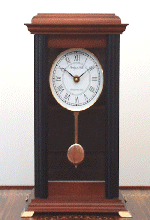 I like this clock. And she likes me. When my duty here is done, I shall
take her for my wife. --Capt. S.S. Hendley
I like this clock. And she likes me. When my duty here is done, I shall
take her for my wife. --Capt. S.S. Hendley |
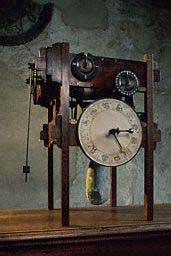 The Davies Clock
The Davies Clock
HOC23448
The Davies Clock was so named for its discoverer, Anton Davies of
Bremen, Germany. Davies found the clock in the sub-basement of a
castle just outside of his boyhood home, shortly after the fall of
Berlin. Attempts to date the piece have met with little success, for
while to the untrained eye it appears to be of modern mechanical
manufacture, there are telling marks that suggest a more complex
history. The rope lever on the left-hand side, for instance, activates
a countdown in spoken Aramaic. The countdown voice is that of
a small child, and while of course there is some kind of mechanical
recording within the clock, one cannot help but notice the voice
become more and more strained and raspy with each pull of the lever. --Sir Peachy Carnehan
|
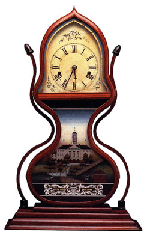 Mother's Clock
Mother's Clock
HOC362436
This clock was one of only two clocks built by Milo Sumurges, the
infamous mathematician, architect, painter, psychologist, horologist
and multiple murderer. The clock originally showed a picture of his
home, built in 1834.
In the course of the criminal investigations, the remains of the
little girls were found scattered, though not sparsely, across the
acres of land surrounding the house. However, the mystery of how
little girls' remains (identified as the victims of crimes from India,
Africa, Alaska, and from as far back as 1630) came to be buried where
they were, has never been resolved. (Although the circumstantial
evidence linking Dr. Sumurges five of the contemporary local victims
was strong enough to send him to an institution for the criminally
insane.)
Like the mystery of the bodies found in the criminal investigation, it
has yet to be explained how the picture of the clock was altered to
that of the sanitarium to which Sumurges was committed in 1848.
Equally puzzling are the reports of visitors who have claimed that the
clock pictures their own home, and that a voice in the clock would
reprimand them for unconfessed trespasses on the half-hour, and would
compliment them and entreat them to come nearer on the hour. -- Eliot Thad Gilvie
NOTE 1: PLEASE DO NOT CROSS THE BARRIER AT ANY TIME, BUT ESPECIALLY NEAR THE HOUR.
NOTE 2: We regret to inform our customers that, because of
complaints of some of our friends in the Brotherhood of Meatworkers,
the other clock of this pair, the Virgin Clock, will not be displayed
in the future. If you find it, please return it to a member of the
staff.
|
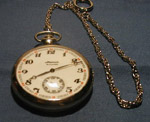 The Three Guinea Watch
The Three Guinea Watch
HOC83049
Exhibited in the Rogue's Gallery
To English-speaking children growing up during the Great War, Talbot
Baines Reed was a well-known writer of adventurer stories, but this is
only partly the truth.
As the writer's hunger for more and more exciting fictions consumed
Mr. Reed, he began to write non-fiction and pass it off as children's
yarns. This clever deception only became clear with his 1914
"Adventures of a Three Guinea Watch," which purported to be a made-up
tale about a pocket-watch which underwent a number of adventures when
it was stolen from (and later returned to) a young boy named Charlie
(Charles) Newcombe. A newspaperman named Swaddling discovered that the
tale was very similar to a case described by Charles Newbald, the once
famous Psychometrist, who would astound Victorian audiences by reading
their clocks and watches and telling disturbingly accurate histories
of these items. Newbald and Swaddling filed a legal complaint against
Mr. Reed in 1915. As news coverage at the time was primarily devoted
to the war in Europe, the case warranted little space in the national
newspapers, but the House of Clocks has a number of clippings
pertaining to the case. These describe how Swaddling and Newbald
began arguing about the facts of the case whilst in court and how
Mr. Swaddling (a fast bowler for the Meopham Gentleman, in his
spare-time) ended the argument by throwing his own Three Guinea Watch
at Mr. Newbald, shouting, "Read this, you old fool!" The watch hit
Charles Newbald in the centre of his forehead and killed him in front
of a judge, a jury and a courtroom of witnesses.
The case against the false-fictionist Talbot Baines Reed was dropped
and Mr. Swaddling's murder case was picked up in its place. Mr Reed's
books were never as popular as they had been before 1915 (Children do
not want their fantasy tainted with reality) and the House of Clocks
now possesses a collection of Mr. Reed's books, a collection of
articles and stage advertisements for Charles Newbald, a number of
watches read by the Psychometrist, and Charles Newbald's murder weapon:
still ticking and telling its tale.
Addendum: There are those that claim that Talbot Baines Reed died
in 1893 and the watch; the newspaper articles and court
transcripts are all forgeries and fictions. If this is true it adds
yet a further layer of irony to the tragic tale of the Three Guinea
Watch. -- Capt. S.S. Hendley
|
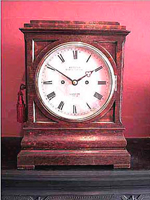 Markham's Oriental
Markham's Oriental
HOC543687
It is strange that, surrounded by the everyday atrocities of the
Shambles, it is this clock that makes me feel sick with shame and
horror. Even "The beast with two hands" that is now kept away from
public display in the basement of the house (and which I have seen
devour a rat, down to the bones) does not appall me as much as this
item. This fine Mantel Clock, with its walnut veneered case, seems at
first harmless and unassuming but in 1857, Joshua Markham, explorer
and inventor, displayed his "Oriental Perpetua" as one of the true
wonders of the modern age. Markham, whilst living amongst the heathen
natives of the Chinese Interior, came across a shrine where a small
ceramic Goddess possessed the ability to pour water, drop by
miraculous drop, from her tiny ceramic water gourd. Markham took the
idol back to Liverpool where he imprisoned her within a wooden
case. Would he have done the same to the equivalently blessed crying
statues of the Holy Virgin? I doubt it. This clock requires no key to
wind the main spring: it is powered by a debased miracle. Each drop of
holy liquid turns a brass water wheel, which turns a series of cogs,
which turn the mundane hands across the profane clock-face. Over one
hundred years later the clock still works, but it is slowing. The
miraculous idol, separated from its idolaters, is drying up, and I am
afraid. I do not want to live in a world without miracles.
--Capt. S.S. Hendley
|
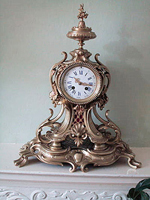 HOC90274
HOC90274
First mentioned in Bernard Fosters rather optimistically titled All Clocks:
Vol I, this hideous device had the capacity to absorb time directly from its
surroundings, never needing to be wound and yet causing nearby objects to rust
or degrade, and living creatures in its sphere of influence to prematurely age
and decay.
After passing through the possession of seventeen successive generations
within a mere twelve weeks, its speed and area of effect were observed to be
increasing and widening respectively.
With all local experts unwilling to approach the clock for long enough to
study its motion, a technical solution to the problem was unforthcoming.
Thus, in 1947, the piece's then owners had the clock swiftly dismantled and,
as a precautionary measure, the pendulum removed and buried in a field in
Wisconsin. -- Mordecai Mulroney
|
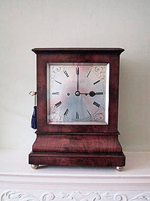 The Second's Sweep (or The Relativity Clock)
The Second's Sweep (or The Relativity Clock)
HOC360601
The first owner of this timepiece claimed that, if the clock is set on
its back and one circles it in time with the second hand,
(i.e. completeing the circuit in one minute), then the person who
circled it can move at a speed relative to their current distance to
the clock. No matter how far away they are, time accelerates for them
so that they are always able to circle the clock in a minute. While
we at the House of Clocks do not believe such claptrap, please do not
try to remove this clock as it is nailed upright to its display. -- Eliot Thad Gilvie
|
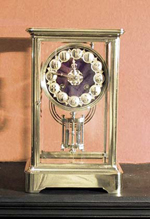 HOC9302
HOC9302
(This descriptive account was found scrawled on a sheaf of balled up
papers, at the bottom of a dirty coffee pot behind the front desk of the
House of Clocks. The contents' accuracy has been unverifiable, but as no
other histories may be obtained regarding this piece, its
contents have been posted here.)
I am distressed to see that the clock you have until now referred to as
HOC9302 is in all actuality a piece known as "Charon's Gate."
The title is a reference to the history of the twelve coins which serve
as the place holders for the hours 1-12.
Gold plated and set in the face of this timepiece, the twelve coins
that adorn the face of Charon's Gate have a grisly history. The
ancient Greeks and Romans believed that the ferryman Charon collected
a toll to ferry the spirits of the dead across the Styx to the
underworld. The dead were always buried or entombed with a coin hidden
beneath the tongue. Each of the coins on the face of this unholy
clock was stolen, post-mortem, from the corpse of a different
emperor of Rome: Otho, Caligula, Augustus, Macrinus, Heliogabolus,
Valentinian II, and six others yet to be identified. Each of these
Emperors was infamous for madness, weakness, or incompetence, and I
believe that it was not by accident that these men were singled out.
I have been unable to ascertain the exact nature of the
clock's powers, but I suspect very powerful necromancy is afoot. The
clock first appears in literature as the face of twelve eyes in an
Old Italian manuscript, although it may not have been a clock at the time
so much as a plaque or plate, or perhaps a sundial. It mentions the names
of the first three Emperors specifically, and hints to the identities of
the latter three. The other six coins are shrouded in mystery.
The name "Charon's Gate" is of course a reference to the mythical
ferryman, but also suggests tha thte clock is itself some sort of door
or gateway. To where, I can only suspect.
The clock itself has a gory recent history, including the
deaths of a famous British actress, and later, a busload of American Boy
Scouts. How or why the clock was involved, I cannot say. My sources are
all unreliable or recently deceased.
Unfortunately, the House of Clocks in Chicago has to be the
absolute last place I would have liked to see this clock end up. Better
choices would have been the bottom of the Pacific Ocean, or dropped in a
cage of large and rather aggressive gorillas.
I am not able, at this time, to come and remove this clock
from your collection for I have recently been given instructions from
the Order of the Backwards Hands that would conflict. But rest
assured, as soon as I find the time, I will adjust my busy schedule so
that this most dangerous time-piece may be properly disposed of.
-- Yours Dearly, Hake Cross O'Read
|
 HOC2037021
HOC2037021
The Smithson-Oredale Clock
This is the only known photograph of the Smithson-Oredale clock,
which is housed on the second-and-a-half floor of the museum. It may
be viewed only with special permission from the curators of the
collection, as the clock must be heavily sedated well in advance.
A date scratched into the bottom of the clock reads 1862, but
many scholars argue that this is a forgery. More evidence to
substantiate this claim is found on a yearly basis. For example,
despite the omission of several minor details (easily attributed to
terror-induced hallucinations on the part of the writers), the
following is a perfect description of the Smithson-Oredale clock.
Excerpt from the diary of Charity Rowse, found in a recently
discovered cache of artefacts from the "lost" colony of Roanoke:
3rd June 1589: Today went to Mister Lane's Home where we were
Greeted by Mrs. Lane with all Cheer and ate. In there [sic] Home are
many Goodes from England including a fine set of fire-tonges and a
Clocke, the Type of which I have never before seen. It has the head of
a great Wolf or Dogge engraved upon the Face where the Moon ought to
be, and Curious silver-pawed-feet.
5th June 1589: Upon Waking today found Virginia Dare outside among
the Chickens. I led her back to her Parents who were very glad to see
her as she had gone Missing. There was a bite, as of a large Cat or
other Creature upon her hand.
13th June 1589: Dear God the Clock is Coming its Chimes Howl like a
Great Beast. Virginia is Outside but I will not let her In, her Eyes
are Yellowe and she Barks. God Help us.
-- Gamaliel R. Devon II
|
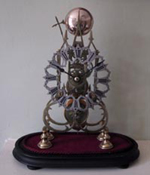 The Nightwatchman
The Nightwatchman
HOC141210
Should you be in this room during a power failure at night and the
only light you can see is the soft, steely luminescence of this
clock's face, please remember, despite the large chain (which you might
catch a glimpse of, behind the clock), do not turn away from it at any
time! Please keep staring at it as you slowly back up to a wall and
then slide your way towards an exit. There is no significance to the
fact that very little has been heard from its owners since it was
bought. --Eliot Thad Gilvie
|
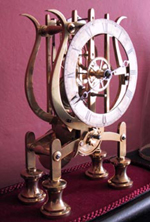
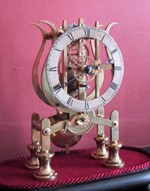 The Angel's Harp
The Angel's Harp
HOC591317
Having an argument with your spouse, your children, your friends,
your coworkers? What better way to soothe their nerves than to let
them listen to the heavenly sounds of this clock? Unique in both its
appearance and and capabilities, its inventor (Jason Hartwick, a
psychiatrist in Dubuque, Iowa) claimed the design fell from the sky to him
in 1916. The sounds of the many harp strings attached to this clock
will quickly have anyone drifting off into a sound, comfortable sleep.
There are lovely copies of this clock available for sale at the museum
shop, so that you can bring the celestial music home. However, we
caution you that you don't want to make any suggestions to the
sleepers immediately afterwards, as the unfortunate Jason did to his
family. We decline to relate what happened then, but it was certainly
no way to use a ladle, a magnifying glass, a rolling pin, newspaper,
and a paring knife (though points should be given for imaginative
useage of household objects). -- Eliot Thad Gilvie
|
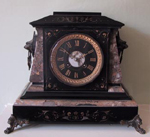
|
 The Necromoniclock
The Necromoniclock
HOC766639
This squat and dour looking timepiece has an extensive and elusive
history. Its exact date of construction is unknown, though it is
believe that its appearance has changed drastically over at least three
centuries.
Sightings of eerily similar, slightly altered versions of this clock
have been recorded in Nazi-era Germany, Pre-Hun Gaul, and in the staff
room of a specific power plant in the vicinity of Three-Mile Island,
Pennsylvania.
In his book, "The Natural and Supernatural History of Certain
Timepieces", Hake Cross O'Reed remarks, "That it is possessed of
sentience, nay, of malevolent intelligence is clear. The reasons for
it appearing to enjoy re-runs of Baywatch and elevator musak are less
so. I suspect it all boils down to one thing: Pure unadulterated
evil. In recent years it has been rumored that this clock has sat
proudly upon the mantle-pieces of such individuals as David Berkowitz,
Charles Manson, O.J. Simpson, and Fran Drescher of the hit sitcom,
"The Nanny." The ramifications of these facts are unclear, but
chilling. It cannot be explained how the clock seems to move so
swiftly from locale to locale. After extensive and difficult research,
the clock's progress can be partially tracked, and the results are
confounding. Appearing on a sales-receipt at a pawnshop in
Whiteville, North Carolina, the clock quickly jumps to a crude
painting on a hide-drum in the Himalayas made only a week later. From
there, the clock jumps to a yearbook picture in Cleveland, Ohio. A man
raising pigeons on a rooftop in London gave an eyewitness account of
the clock "hoverin', malicious-like" only two hours after the
before-mentioned yearbook picture was reportedly taken. This clock
seems to cut a swath of destruction everywhere it goes. Those who have
spent time in its direct vicinity have complained of nosebleeds,
murderous impulses, and an uncontrollable desire for polyester
clothing. Large crowds of people have been driven to riot by its
raucous chime. From botched plastic surgery to cattle mutilation (and
in some cases both), from earthquakes to fallen souffles, doom and
despair mark the passing of this clock in all its many incarnations. I
can only hope that the Necrinomi-Clock was drawn to the House of
Clocks, as so many other accursed appliances of chronological-deviancy
have been, to retire. Otherwise, the future may not be looking kindly
upon that fair House."
|
 The Sophisticate's Mystery or The Swindler's Clock
The Sophisticate's Mystery or The Swindler's Clock
HOC 71514
This clock seems to have been a favorite of Jean Baptiste
Tavernier. There is wide belief that Tavernier cheated the clock-maker-
someone we only know as Teu- and then had the gall to ask Teu to repair
it. The clock was repaired and was described by contemporaries as one of
the finest pieces of all wood mechanical craftsmanship ever seen. After
that, Tavernier often had it on his desk. Then, gold and jewels started
disappearing from Tavernier's quarters on his ship. Many men were
accused of stealing and punished until Tavernier realized the clock had
gilding on it. Tavernier quickly sold the clock, but, soon after, the
buyer mentioned to him the clock had disappeared amongst other expensive
valuables. Sure enough the clock was back on Tavernier's desk more
golden than ever. Tavernier then decided to drop the clock into the
ocean immediately before leaving port. He never saw the clock again,
which was fortunate. On that voyage to India, Tavernier bought a diamond
that would later be known as the Hope diamond.
The clock next turned up in Holland, owned by Thomas Blood. He took
it with him back to England where he eventually tried to steal the Crown
Jewels. While he was definitely a rogue, this caliber of work was
definitely out of character for Blood and doomed to failure. When his
silver tongue gained him a pardon, he returned home to find the clock
missing.
There have been numerous vague accounts of the clock's
whereabouts but the next verifiable one is in the 1840s, when the
clock was found to have multiplied all over the American West and hunters
were given two dollars for the carcass of any of the clocks. By the
1850s, the clock was thought extinct.
However, we acquired the clock from the Smithsonian when it was
found in the Janet Annenberg Hooker Hall of Geology, Gems, and Minerals
after being repeatedly removed to the Lost and Found.
You may pick up your jewelry and watches as soon as you leave the
room, and please depart immediately if you have any expensive fillings. -- Eliot Thad Gilvie
|
 Mr. Markeson's Body Clock
Mr. Markeson's Body Clock
HOC9723
Upon rounding the corner into the ground floor's eastern hallway,
visitors will find themselves confronted by the late Mr. Terrence
Markeson, stood upright in his display case. Dressed in formal evening
wear, his moustache smartly greased, Markeson's preserved body cuts a
stylish figure, despite the waxen skin and sunken eyes.
One of the most prominent and outspoken members of the International
Brotherhood of Meatworkers, Mr. Markeson was also a generous patron of the
House of Clocks, and kindly donated his body to the House after death,
along with explicit directions detailing how it was to be utilized. In
accordance with these instructions, the House's expert clock-restorers
set to work transforming the cadaver into a time-piece. The interior was gutted, the contents removed and replaced with
metallic substitutes, superficially resembling the extracted organs but
moreover acting as the clock's cogs and gears. This marvellous piece of
ingenuity can be viewed every afternoon when the chest is opened, the two
halves of Mr. Markeson's ribcage and waistcoat swinging outwards on
cabinet hinges to reveal the intricate mechanism beneath.
The deceased's polished glass eyes independently rotate in
order to display the passing of time; the left eye marking the hour, the
right marking the minute, although currently the former has ceased its
movement and remains fixed in the two o'clock position, awaiting repair.
The "ticking" you hear is the slow and regular chattering of Terrence
Markeson's teeth, caused to clamp shut each second by a small piston in
the jaw. These miniature hydraulics are supplied by thin copper piping
which leads under the floorboards where it connects to the House's
heating system, and account for the plumes of steam which are continually
breathed out of the dead man's mouth. -- Mordecai Mulroney
|
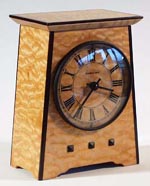 The Folding Clock
The Folding Clock
HOC 12018
This clock is obviously one of our favorite clocks, mostly because
of its relative docility. Twenty-two times a day, when the hands
overlap, this clock moves, folds, rotates, and shifts into a different
shape. So far we have counted five hundred and seven different clocks
into which it can change, from clepsydra and sundials to hourglasses and
mechanical to digital and atomic. We have yet to discover its inner
workings as this seems to irritate it, causing openings to shut so
suddenly that tools have been snapped and fingers threatened. Its
origins are unknown, but vague references are numerous including the
works of Galileo, the Grimm Brothers, William Blake, and Nietzsche. We
chose this photograph as it seems to be a favorite and the form that it
most often takes; that and the fact that every other picture seems to
disappear in a short time. If you wish, we do allow viewings of the
clock's transformations- approximately 1:05, 2:11, 3:16, 4:22, 5:27,
6:33, 7:38, 8:44, 9:49, 10:55, and 12:00- but please do not leave
anything in its room when you leave, as we like it just the size it
already is. -- Eliot Thad Gilvie
|
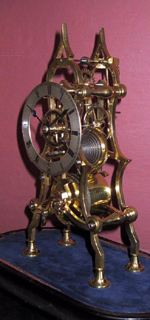
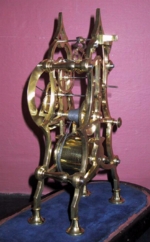 Louis Pooks Hekatomb Horologika
Louis Pooks Hekatomb Horologika
HOC007348
This is not really a clock in the strictest sense of the word:
although its design and manufacture closely mimic a conventional
timepiece, it is more accurately classified as a novelty
time-bomb. When the key is turned and the device wound, one spring
controls the rotating hands to count down the twelve minute warning,
whilst the second spring holds enough kinetic energy to burst open the
case and shower dozens of sharp brass cogs and levers across the
parlour. In a description written by one James Horlock, age 12, the
events which folowed were described thusly: "Great fun for everyone!
Oh the shock and joyous excitement as father was roused from his
afternoon slumber, mother lost her concentration and stuck the lace
pin in her thumb and deplorable cousin Jim, who was encouraged to
stand close to the fire (and therefore close to the clock on the
mantel) had to pick the shrapnel from his forehead." This device was the
toast of the mid 19th century (copies were owned by all the crowned
heads of Europe) and no one is known to have died from his or her
wounds. So, in retrospect, it was a harsh decision that brought about
its ban in France and from there to be banned or discouraged
throughout mainland Europe and the colonies.
Due to the difficulties of rebuilding the clock after an explosion,
the fickleness of the novelty market, and France's 1859 ban, very few
complete copies of this remain. Although much of the outer-decoration
and casing is missing, the House of Clocks is proud of its Hekatomb
and keeps the clock-key locked and out of the reach of children and
professional pranksters. -- Capt. S.S. Hendley
|
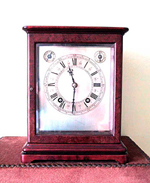 HOC2246
HOC2246
This piece was originally one of pair of clocks, the last to be crafted by
reclusive Siamese twin chronologists, Edward and Gilbert Croft. Each of the
conjoined craftsman would imbue their clocks with a particular individual
style; ranging from the simple inclusion of engraved initials, to the
smearing of the mechanism with fluids of personal supply. This appears to
have endowed each piece with a peculiar sympathy with its creator.
Famously, the horological pair had no great affection for one another, an
animosity no doubt resulting from their enforced proximity, and this ill
feeling seemed to be shared by the clocks themselves, refusing to be placed
within an inch of each other, as if propelled apart by means of magnetism.
At the time of Edward's death at 6:27pm on January the 4th, 1892, his
half of the pair of clocks was said to stop dead in its motion at the
very same instant, that of his brother stopping, equally inexplicably,
upon his own death, a full thirty-seven minutes later.
Upon their demise the extent of the brothers' hostility towards one
another became apparent. The Last Will and Testament of each revealed
that they had chosen separate fates for their bodies after death,
Edward choosing cremation, Gilbert opting for more traditional
interment.
After a long and compelling court case, something of a cause célèbre
in the national press of the time, the judge ruled that each of their
wishes should be respected, a decision easily effected through the
employment of two sturdy undertakers and a bone-saw.
It is said that at the precise moment of Edward's cremation, the Croft's
Workshop was tragically and mysteriously gutted by fire, a blaze which
resulted in the destruction of Edward's clock, while leaving that of his
sibling miraculously untouched.
The remaining piece, now permanently separated from its charred
brother, was brought for exhibition at the House of Clocks, where the
intriguingly coincidental sequence of events surrounding its history
has proven suggestive for the more fanciful of our visitors, many of
whom claim that Gilbert's clock is imbued with the pungent smell of
earth and graveyard ivy. -- Mordecai Mulroney
|
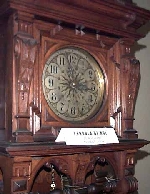 Samuel's Future
Samuel's Future
HOC203404
When Samuel Stokes told his wife Maddy that he was building a time
machine out of their old grandfather clock, Maddy did not laugh. He was
a serious fellow, influenced as much by H.G.Wells as by Albert
Einstein, and not a man to change his mind.
And so, a year later, when Sam opened the clock-case and stepped
in, Maddy closed the door behind him and agreed to wait for her
husband's return. It was a very quiet three minutes before Maddy heard
a rapping from the clock-case door. It was Sam, asking if his wife
could push a biscuit through the crack in the case and into his
future, as he was feeling hungry. Maddy asked what the future was
like, to which Sam replied, "It is dark and cramped (much like the
inside of a grandfather clock)." For thirty-seven years, Samuel Stokes
lived in the future and would not allow Maddy to open the door on the
grounds that allowing the two time-streams to merge might prove
disastrous. She never complained, nor (despite advice from friends)
did she divorce her absent husband. She just continued to post
lettuce, slivers of cheese and meat and biscuits through the crack and
pour water through the keyhole.
This clock is a monument to the stubbornness of an amateur
scientist, the patience of Mrs. Madeleine Stokes, or perhaps the first
successful amateur time-traveler. The Stokes family donated this
clock, with the understanding that the door should never be opened and
the contents (the pale emaciated body of stubborn Sam or a dark and
cramped future) remain a mystery. -- Capt. S.S. Hendley
|
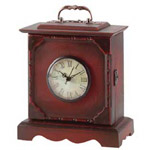 The Fowler Clock
The Fowler Clock
HOC8830
Mr. J. Fowler of New Hampshire happened upon this piece in 1975 while
rooting through local refuse. An amateur clock-maker himself, Fowler opened
the casing in order to oil the gear train, discovering in the process a nest of
Polemistus Abnormis, a species of rare wasp native to the Russian steppes.
As Mr. Fowler noted, the nest itself appeared to block the free movement of
the gears, an accident of nature which would be expected (under normal
circumstances) to impede the clock's function. In this curious case, however,
the motion continues. "Eppur si ticke," as Mr. Fowler would often say, to
limited amusement.
Despite this off-putting interior, the piece is serviceable, presuming of
course that one can endure the incessant buzzing, and tolerate the infernal
sound of scratching and flapping of wings that precedes each striking of the
hour. -- Mordecai Mulroney
|
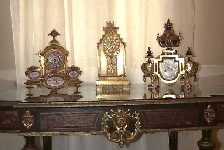 Reliquary clocks
Reliquary clocks
HOC2359, 3260, and 3261
These three clocks are rare examples of the practice of taking
reliquaries of either personal or religious significance and turning
them into clocks.
The clock in the middle of this trio is of special interest to the
historian. The house-shaped body of the clock is actually a reliquary
purportedly containing the tongue of Saint Beryl Articulatus of
Cracow. According to legend, Beryl was a young woman who was
betrothed against her will to a pagan, Prince Casimir. On their
wedding night she prayed to the Lord to intercede, ... [and] the Lord
granted Beryl the miraculous ability to chatter continually about
whatever was on her mind, however inconsequential, without pause for
breath or food. While Saint Beryl was born and died in the middle
of the fifth century, the reliquary is a nice example of twelfth
century workmanship. The reliquary came into the possession of
wealthy eccentric John Gratzen around 1860, and he commissioned famous
French clock-maker to add the clock mechanism to the round window of
the church-like structure.
|
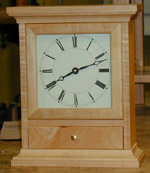 The Conjurer's Clock
The Conjurer's Clock
HOC3320
A spring-loaded drawer in the base of this clock becomes accessible for
fifteen minutes after every thousandth chiming of twelve, that is, once every
five hundred days. Each time the drawer has been opened thus far it has borne
a different gift, including a wicker doll, the torn corner of a photograph, a
severed human finger (male), and three death-watch beetles.
This charming and surprising piece was built by the now largely forgotten
illusionist Alfonse de la Poderoso (real name Ivor Hennessy). Hennessy's
life-long claim of having invented "A Contraption of Appearedments and
Dissapearedments Without the Use of Trapdoors, Mirrors, or Hidden
Compartments" was greeted by the magical community with predictable derision.
When pressed for an explanation, Hennessy released a fourteen page document,
described by his leading rival (The Astonishing Horatio) as "Incoherent
twaddle from beginning to end. What are we to make of such
phrases as 'The quaquaversal empowerment stems from circulatory resonance,
thrice around cypseloidally, thus focusing the stream?' The lack of respect is
implicit."
Dismissed as a fraud, Hennessy died in squalor in 1968 in a Kentucky
cheaphouse, and the clock was sold by his estate. Its subsequent effects
have been rejected by the now elderly (and presumably less astonishing )
Horatio as a hoax perpetrated by Hennessy's great-grandchildren in order to
revive their ancestor's reputation. Naturally they deny the claims.
The House is understandably reluctant to involve itself in such disagreeable
feuding, although it should be noted that at the time of the clock's last
opening (17th of December 2002), a small handwritten note was revealed.
We reproduce it here without further comment.
All may not yet be knowned of this Horatio, his noisome estrangement from
the balneological arts notwithstanding, the man is no less a crapulent sot,
and a perfidious one at that.
-- Mordecai Mulroney
|
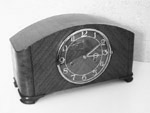 The Godwin Clock
The Godwin Clock
HOC4850
Although in all other respects, this clock seems to be simple in both
mechanism and design, the Godwin clock is unique in its visual
idiosyncrasies, to whit the fact that the chronograph in question is
only visible when photographed. Constructed under unknown conditions
by Mr. William Godwin of Illinois, the piece was then bequeathed to
his inheritors, with strict instructions never to be touched without
first availing oneself of thick gloves, lest the clocks particular
transparency be conveyed through the skin.
It became custom for the family to have the piece photographed, at
which point one of the Godwin children, thinking it an enthralling
game, would count the passing of seconds on their fingers until the
photograph was developed, sometimes as many as four days later. They
would then study the image and add the counted figure to that shown on
the clock face in order to ascertain the current time.
Suggestions that an easier method of keeping time might have been
achieved by simply purchasing a regular time-piece or enquiring of a
neighbour were greeted by the Godwins with scorn and the insistence
that this would betray the memory of their beloved ancestor. The
wisest of guests would refrain from pressing the matter for fear of
swift eviction from the family home. This photograph of the clock was
taken shortly after its delivery to the House in early 1916. Sadly,
not more than four months later, a careless cleaning woman of, it must
be said, dubious repute, seems to have moved the clock while
endeavouring to clean it. Needless to say neither the cleaner nor the
piece have been seen since, although the chiming of the latter and the
embittered complaining of the former are occasionally heard emanating
from uncertain location. -- Mordecai Mulroney
|
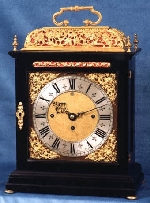 Tabitha Tweed's Mantel Clock
Tabitha Tweed's Mantel Clock
HOC205680
This is of particular interest to local experts in
nursery rhymes and folk tales, because it is believed
to be Tabitha's s original clock - the same clock that
children living in the Shambles in the 1940s used to
sing about with murderous glee:
Miss Tabitha once had a nice little clock,
And she placed it upon the mantel.
Her father returned drunk from the dock,
And said time it was insubstantial.
He said it was relative' useless,
And hadn't a useful meaning.
He knocked the clock from the mantelpiece,
And hit Tabitha for screaming.
Then he stormed out of the house again,
In an angry mood and surly,
And crossing the mainline was hit by a train,
Ironically five minutes early.
-- Capt. S.S. Hendley
|
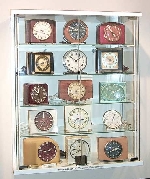 HOC3589-3603
HOC3589-3603
This installation recreates, in situ, a portion of the clock
collection of Margaret Kettleson-Kohn. Ms. Kohn is most familiar as
the wife of Senator Albertus Kohn, often called the father of modern
political dialogue. Mrs. Kohn was known for her influence on her
husband's speeches, which she always criticized for being too
lengthy. The famed Life Magazine photo of Mrs. Kohn holding a
stopwatch next to her husbands ear during a political debate has
become a cultural touchstone of many of the boomer generation. After
retiring from public life, Senator and Mrs. Kohn became the subjects
of many rumors. The most prevalent (and it appears, well-founded) rumor
was that Mrs. Kohn's temporal obsession had reached such a fever pitch
that she filled every available space in their antebellum mansion with
timepieces so she would, as former employees claimed, "Always know
exactly when." The rest of the Kohn collection is filed in boxes 114
through 498 in the House of Clocks archival vault. -- Sir Peachy Carnehan
|
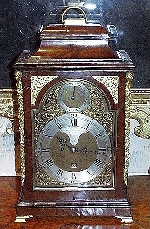 The Harbinger's Clock
The Harbinger's Clock
HOC4301
It is reputed that this timepiece has but one purpose: counting down each moment until the end of reality as we know it.
The exquisitely detailed etchings on the gilded face of this piece are
minute representations of the armed forces of Heaven and Hell.
Brandishing shields, spears, and swords, the angelic phalanx pours down
from the upper-right hand corner of the clock-face towards the boiling
legions of demonic hell-spawn, armed with barbed flails and human limbs
in the bottom-left; forever drawing closer to one another with each
ticking second of the clock.
With each tick of the internal mechanism, the forces of orderly
good and chaotic evil grow ever closer, until the Final Confrontation.
The distance closes with every moment, although at such a
slow speed and immeasurably tiny distance that their progress cannot be charted. Accurate measurements are of course difficult to obtain at these speeds, but to a near approximation, in last 1500 years the forces on
the face of the clock have closed no more than 1/28th of an inch.
-- Hake Cross O'Reed
|
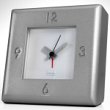 HOC176889
HOC176889
Despite the best efforts of four consecutive owners,
this clock always appears to be out of time with every
other clock in its vicinity. Since it has been in the
possession of the House of Clocks it has remained
stubbornly out-of-sync with every other exhibit in the
collection. It has been dismantled twice and many of
the parts have been replaced but still its inability to
synchronise with any other device borders on the
obstructive. -- Capt. S.S. Hendley
|
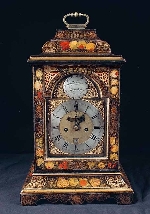 HOC472289
HOC472289
Donated by Mr. C.J. Perry of the Brotherhood of Meatworkers
This clock was constructed by Mr. C.J. Perry, who it is believed
was an apprentice for the great Meat Clock (no longer on Public
display for health reasons). This clock comes with a caveat: Looks can
be deceptive. That piece looks like it is made from metal. This bit
looks like it is coated with enamel. That other piece looks like
wood. As a whole; the item looks like a pleasant clock manufactured by
normal sensible means. In fact this is a masterpiece of ossuary and a
wonder of the preservers arts. Looks can be deceptive but on a hot
day, your sense of smell cannot be deceived. -- Capt. S.S. Hendley
|
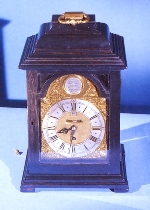 HOC41038
HOC41038
Auctioned among the effects of the self-proclaimed marquis of Colorado, this
is one of the House's many clocks which feature extraordinary winding
mechanisms. The device in question is invariably either glossed over
completely or mentioned only as a scant footnote in most horological
publications due to its morally questionable design. We are given to
understand that a large number of infants browse these electronic pages and so
naturally we are loathe to discuss the vulgar mechanism in unnecessary detail,
however, the more bohemian among our visitors may gain enlightenment from the
fact that the clock features a cylindrical cavity in the rear, and a pair of
sturdy brass handles were originally positioned on either side of the casing.
Needless to say the piece was thoroughly cleaned before exhibition, and again
following the distressing incident in the spring of 1953 which has been
recounted in full elsewhere and will not be repeated here. Suffice it to say
that the gentleman in question was severely reprimanded, although one fears
that the minds of the witnessing schoolchildren may have been tarnished beyond
measure, and the nature of their future marital relations thrown permanently
into doubt. -- Mordecai Mulroney
|
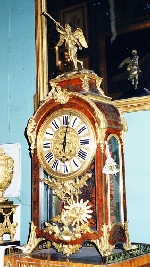 Gabriel's Clock
Gabriel's Clock
HOC9235
(Excerpted from "Strong Clocks for a Gilded Age," by Lord Edmund
Newcastle, London Horological Press, 1888)
Gabriel's Clock has long enjoyed a reputation as a cursed timepiece
within the Horological circles, a reputation that only serves to
underscore the ignorance rampant in this community. The clock first
appeared in the court of Versailles a mere three months before the
first stirrings of Gallic rebellion inflamed mobs in Paris to abandon
reason for the Guillotine. The Clock passed into the possession of
several radical Frenchmen and ended in the collection of Napoleon, who
ascribed his defeat in 1799 at the crusader city of Acre to the
clock. Writing in his unpublished memoirs from St. Helena, "I could of
course blame the generals, who gave in to damn near every one of Blast
William Sydney Smiths advances, or even blamed the cursed Turks who
surrendered with all the rapidity of a snake breeding, but I know
where the true blame is to be found and it is in and on the hands of
the damned clock."
After Napoleon's supposed death the clock passed into the hands of
American travelers. Ownership of the clock has been ascribed to many
august personages over the past eighty years, including Americans
Zachary Taylor, John Brown and the Raj of India.
The photograph of this clock was arranged under the supervision of the
clock's current owner, Sir William Witney Gull. -- Sir Peachy Carnehan
|
 Hake Cross O'Reed
Hake Cross O'Reed
HOC950322
This clock was built like any other: from wood and brass and enamel
and glass. How it attained sentience and began masquerading as a human
being is currently unknown. While in human form, it had a number of
morally ambiguous misadventures, including contributing its expertise
to the panel of Horologists catologing the clocks in the House, and
other activities which have been chronicled in the House's
guestbook. It is up to the reader to decide what resemblance the
guestbook bears to truth, but the horological information O'Reed
contributed to the House has proved solid and verifiable.
When representing itself as human, it called itself Hake Cross O'Reed
and we have allowed it to retain this title. However, certain
precautions were taken when the clock was returned to the House's
custody, and cold iron chains have been attached to its feet to
prevent it from escaping again. The words "Preserve Us All" are
engraved upon its pendulum disc.
Mr. Hake Cross O'Reed leaves behind him a daughter and
varied collection of enemies. -- Capt. S.S.Hendley
|

